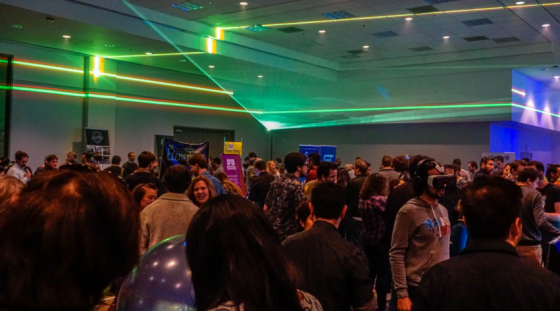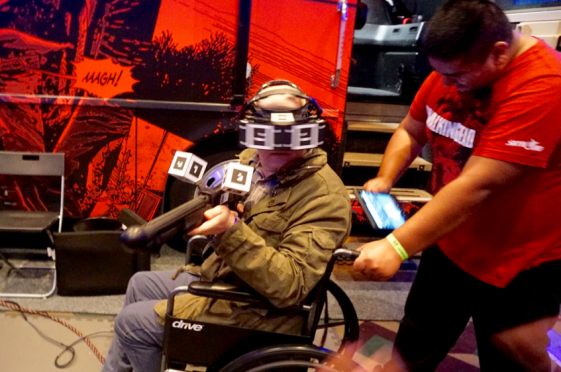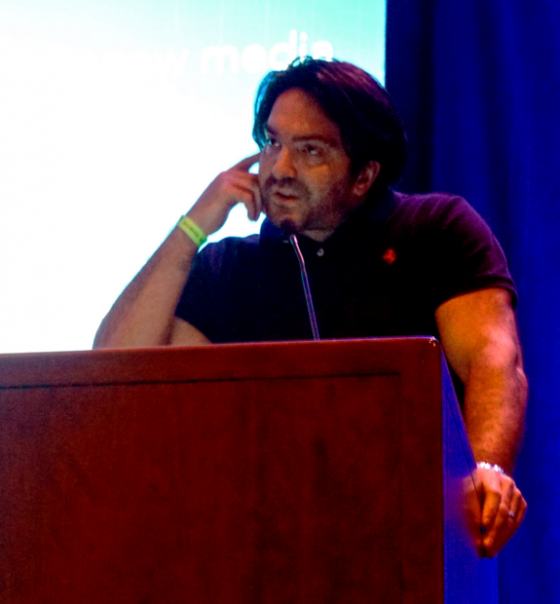Virtual Reality Los Angeles (VRLA) is a local enthusiasts meetup with 5,000 attendees. Tech vendors, studios, and fans are all learning together.
By Kathleen Maher

One has to love the VRLA meetup event. It’s earnest, young, brash and fast growing. The latest meetup attracted 33 sponsors and 5,000 attendees. It’s also kind of a practical community drawing from the lessons of being a Hollywood factory town. The developers in the LA scene woke up to VR thinking about distribution, storytelling, and production.
AMD is a huge supporter of VRLA. In fact, the company has been early to embrace VR. The company introduced Liquid VR, which enables smooth playback sync’d between the PC and the glasses. The company, and AMD’s corporate VP alliances Roy Taylor, and Daryl Sartain, director of AMD’s VR group, has been supportive of VRLA from the very start. AMD hosted the VRLA keynotes which addressed presence: how to go from being passive VR and just looking around content, to being able to move and interact, and finally have some sense of one’s body in VR.

The truth of the matter—and it’s very evident in much of the content available now—people are just learning the ropes of VR content.
VRLA co-founder Johnny Ross quoted Digi-Capital saying over $686 million has been raised by VR companies. He thinks that each new advance in VR brings in new converts and helps build the potential for VR to become a success. He said every time people can go beyond the “look around” experience afforded by mobile VR setups like Cardboard and other phone-holder systems and graduate to moving in VR, walking in VR, and controllers which return the use of one’s hands, they are better understanding the transformative power of VR. He says, it’s as if a door has closed behind you—your perception of the world has changed. For Ross, it’s almost a religious experience and he says the concept of the soul piloting a body starts to make more sense. Yes, these people are practical, but they’re also true believers.
At this year’s VRLA even more people had a shot at that kind of epiphany, as there were more than a dozen demos that allow people to walk around. Epic’s highly anticipated Bullet Train from drew huge long lines of users—many of whom had to make a choice, spend the hours in line for this experience and miss the others? They did it.

AMD’s approach to VR is similar to their approach to any major software market. The company is working directly with the leading software developers to optimize its drivers for performance and stability.
Relying (and creating) open approaches has been core to AMD’s strategy against its better-funded competitors. At VRLA, Taylor introduced AMD GPUOpen.com, which went live on January 26.
The website will offer:
- Direct Access: Unprecedented GPU control
- Open Source Software including effects, tools, libraries, and SDKs including Liquid VR
- Develop industry standards with industry participation
AMD will walk developers through all the resources available in GPUOpen at GDC 16.
VR First, building content creators
Crytek has stepped up to help lead the establishment of VR training, and in the process help define standards for good VR content. It has established VR First, a network of training facilities worldwide. AMD is also a partner in the program. Crytek founder and president Cevat Yerli talked about VR First as a way Crytek can give back to the gaming community and also help foster the development of a strong VR developer community. “We want to be something that is more meaningful; how can we contribute; how can we mentor?” asks Yerli of Crytek. VR First will build start of the art facilities around the world. One of the first sites is at BAU University in Istanbul, but Yerli says there are new sites coming all over the world. The core group is also building a VR First Council that will include academic partners, media partners, and investors.
Crytec also showed off a new game at VRLA. Yerli said they wanted to experiment with presence. Crytek’s new game, The Climb, recreates rock climbing. He said players can use their hands, they can look around, and they can experience the thrill of rock climbing and the scary effects of defying gravity. Yerli says thinking about a new experience like climbing instead of building the same old FPS based games, helps Crytek find their own bleeding edge for inspiration. The game’s POV metaphor still has something in common with first person shooters, but instead of that gun that hangs out in space, Crytek gives you two disembodied hands to use to search for handholds and negotiate a cliff. Yerli says that everything they learn developing VR games like the Climb are being bed back into the Crytek’s Cry Engine development tool.

Right now, developing VR content is very difficult. People aren’t sure how to do it but even more important, people aren’t sure they’re going to make money on something that is a difficult and expensive process. Roy Taylor at VRLA observed the fabulously lucrative game community of today can track its growth spurt back to the introduction of Sonic the Hedgehog in 1991. Taylor asks if Sega’s consoles would have become as popular as they did if it had not been for that wildly popular game. Now, he says, VR needs something similar – something compelling enough to make people want to shell out money for expensive headsets and upgrade their computers.
Survios is all in on presence—they’re bringing in the whole body. This is a closely watched startup. They snagged $4 million in investments in 2014 and have promised to deliver a holodeck experience. The investors represent some old hands tracking technology breakouts. Shasta Ventures partner Rob Coneybeer led the investment and he will take a position on the board. Coneybeer was also an early investor in Nest. Michael Chang who was a corporate development director at Electronic Arts and is now a managing director of Mayvent Partners is an investor and advisor. Gen Isayama of World Innovation Lab and Renata Quintini of Felicis Ventures have also put in.
Also USC is a central part of the Survios story (and of many stories at LA VR). Key Survios employees James Iliff Chief Creative Officer and CEO Nathan Burba did much of their work at USC on what they called Project: Holodeck. They’ve produced several demos including Wild Skies and Zombies of the Holodeck. At VRLA Iliff and Burba said they consider active VR to be critical to the experience of VR, as is presence. The ability to move around is hard-wired for people the ability to incorporate natural movement into content has the potential to improve the experience making VR more practical for long visits. Their vision of VR features multiplayer interaction, natural movement, and game controllers. They’re working with Six Sense. Survios threw a party after VRLA and people were able to play Ray Data, a new game from Survios using the HTC Vive Pre headsets. Their Demo at VRLA used Oculus headsets and it includes positional tracking so the world updates in relationship to the players’ positioning and actions.
Survios demonstrated a multiplayer game that let two players team up to battle common foe. During their talk at VRLA, Burba and Iliff said they’re concentrating on developing an architecture to enable multi-player interaction, recognize facial expression, social networking, and support for cinematic spectating. Gameplay at the VRLA party was broadcast on Twitch.
Another favorite was the return of the Walking Dead demo created by Starbreeze. The Starbreeze demo is another a zombie title but it puts players in wheelchairs that shudder and shake as players struggle to shoot as many zombies as they can. Starbreeze has been publicizing their work with a rolling demo—a tourbus traveling to events across the country. At VRLA Starbreeze CTO Emmanuel Marquez announced that Starbreeze is planning a VR arcade in Los Angeles called the Project: StarCade.
Building a new medium
VR is a new medium and as such it still owes much to the older forms of media that have gone before – all of it. Developers are trying out all kinds of approaches and hoping to take the best from each one. We’re seeing lots of rock and roll concerts in VR, VR plays, arcade games, and even painting in VR. Right now, VR is exclusionary—the person in that helmet is living in a world alone but the industry is experimenting with ways to bring in spectators to see what the player is playing. In architecture, the walk through has been upgraded with VR technology to provide interactive capabilities to explore designs, move furniture, understand the scale of projects. But, so far, most of what we’re seeing is imitating what has gone before. VRLA saw several steps towards the development of a new medium. There is a palpable longing for content that does not trap people behind a floating hand (or gun, or crossbow, or nuclear powered phase shifter, or crowbar) but instead gives them the ability to be creative and move naturally.
There is a lot going on in VR and this vibrant, LA-based community is helping to define the ways in which VR is going to develop as a storytelling medium, as a game medium, and as a documentary medium. People love to discuss, to a tedious extent, how this wave of VR differs from its first stages in the mid-90s, but the answer seems obvious. This wave reflects the long slow simmer of the technology in the intervening decades. It has been informed by 3D content creation for movies, and architecture, and transformed by the language of games.





